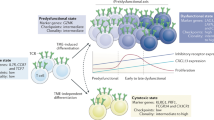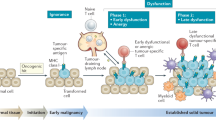Abstract
We have taken advantage of a recently described technique of transformation and immortalization of T lymphocytes using the lymphotropic Herpesvirus saimiri, to achieve long-lasting T-cell lines from gastric cancer patients and healthy volunteers. Blood samples were drawn and T lymphocytes were transformed. Once sustained growth was observed, lines were subjected to phenotypic and functional analyses, and the results compared with freshly isolated peripheral blood mononuclear cells. Cytofluorometric analysis revealed that CD3 and CD45 were found at lower proportion in primary cells from patients than from control individuals (54% vs 75%, p<0.001, 90% vs 96%, p<0.05, respectively), and in HVS-derived T-cell lines (90% vs 98%, p<0.05, 97% vs 100%, p<0.05, respectively). Proliferative analyses showed that primary isolated cells were unable to respond adequately to CD3-, CD2-, and PHA-mediated stimulation, as compared to controls. Similarly, T-cell lines from patients proliferated to a lesser extent when CD3- and CD2-mediated stimuli were considered, especially when simultaneous stimulation via CD3 and CD2 molecules was carried out (47,824 counts per minute [cpm] vs 121,478 cpm, p<0.05). Altogether these results show that the defects reported in T cells from patients with cancer are not exclusively due to tumour-derived factors, since the alterations persist in long-lasting, HVS-transformed, T-cell lines, suggesting that this model seems a suitable one to disclose them.


Similar content being viewed by others
References
Burnet FM (1970) The concept of immunological surveillance. Prog Exp Tumor Res 13:1
Kim CW, Choi SH, Chung EJ, Lee MJ, Byun EK, Ryu MH, Bang YJ (1999) Alteration of signal-transducing molecules and phenotypical characteristics in peripheral blood lymphocytes from gastric carcinoma patients. Pathobiology 67:123
Mizoguchi H, O'Shea JJ, Longo DL, Loeffler CM, McVicar DW, Ochoa AC (1992) Alterations in signal transduction molecules in T lymphocytes from tumor-bearing mice. Science 258:1795
Zou JP, Shimizu J, Ikegame K, Yamamoto N, Ono S, Fujiwara H, Hamaoka T (1992) Tumor-bearing mice exhibit a progressive increase in tumor antigen-presenting cell function and a reciprocal decrease in tumor antigen-responsive CD4+ T cell activity. J Immunol 148:648
Loeffler CH, Smyth MJ, Longo DL, Kopp WC, Harvey LK, Tribble HR, Tase JE, Urba WJ, Leonard AS, Young HA (1992) Immunoregulation in cancer-bearing hosts: down-regulation of gene expression and cytotoxic function in CD8+ T cells. J Immunol 149:949
Ernst P (1999) Review article: the role of inflammation in the pathogenesis of gastric cancer. Aliment Pharmacol Ther 13:13
MacDonald TT, Bajaj-Elliott M, Pender SL (1999) T cells orchestrate intestinal mucosal shape and integrity. Immunol Today 20:505
Hellstrom I, Ledbetter JA, Scholler N, Yang Y, Ye Z, Goodman G, Pullman J, Hayden-Ledbetter M, Hellstrom KE (2001) CD3-mediated activation of tumor-reactive lymphocytes from patients with advanced cancer. Proc Natl Acad Sci USA 98:6783
Biesinger B, Muller-Fleckenstein I, Simmer B, Lang G, Wittmann S, Platzer E, Desrosiers RC, Fleckenstein B (1992) Stable growth transformation of human T lymphocytes by Herpesvirus saimiri. Proc Natl Acad Sci USA 89:3116
Mittrucker HW, Muller-Fleckenstein I, Fleckenstein B, Fleischer B (1992) CD2-mediated autocrine growth of Herpesvirus saimiri-transformed human T lymphocytes. J Exp Med 176:909
Rivero-Carmena M, Porras O, Peláez B, Pacheco-Castro A, Gatti RA, Regueiro JR (2000) Membrane and transmembrane signaling in Herpesvirus saimiri-transformed human CD4(+) and CD8(+) T lymphocytes is ATM-independent. Int Immunol 12:927
Martín-Villa JM, Ferre-López S, López-Suárez JC, Pérez-Blas M, Castellano-Tortajada G, Sánchez-Gómez F, Arnaiz-Villena A (1998) Successful in vitro immortalization of human intestinal mucosal lymphocytes with Herpesvirus saimiri. Tissue Antigens 52:430
Cho MY, Joh YG, Kim NR, Jung SI, Bae JW, Kim YC, Koo BH, Whang CW, Suh SO (2002) T-lymphocyte subsets in patients with AJCC stage III gastric cancer during postoperative adjuvant chemotherapy. American Joint Committee on Cancer. Scand J Surg 91:172
Hong WS, Hong SI, Kim CM, Kang YK, Song JK, Lee MS, Lee JO, Kang TW (1991) Differential depression of lymphocyte subsets according to stage in stomach cancer. Jpn J Clin Oncol 21:87
Weiss A, Littman IR (1994) Signal transduction by lymphocyte antigen receptors. Cell 76:263
Takahashi A, Kono K, Amemiya H, Iizuka H, Fujii H, Matsumoto Y (2001) Elevated Caspase-3 Activity in peripheral blood T cells coexists with increased degree of T-cell apoptosis and down-regulation of TCR zeta molecules in patients with gastric cancer. Clin Cancer Res 7:74
Taylor DD, Bender DP, Gercel-Taylor C, Stanson J, Whiteside TL (2001) Modulation of TcR/CD3-zeta chain expression by a circulating factor derived from ovarian cancer patients. Br J Cancer 84:1624
Saito T, Duss I, Dworacki G, Gooding W, Johnson JT, Whiteside TL (2000) Spontaneous ex vivo apoptosis of peripheral blood mononuclear cells in patients with head and neck cancer. Clin Cancer Res 5:1263
Isakov N, Biesinger B (2000) Lck protein tyrosine kinase is a key regulator of T-cell activation and a target for signal intervention by Herpesvirus saimiri and other viral gene products. Eur J Biochem 267:3413
Acknowledgements
This work was supported by a FIS grant (99/0999). We thank the Centro de Técnicas Inmunológicas (Universidad Complutense de Madrid) for technical support, Pilar Lucea, Paloma del Pico, and Genoveva Vallejo for help in the shipment of samples, and Ángeles Mencía for help in growing cell lines.
Author information
Authors and Affiliations
Corresponding author
Additional information
APV and MP-B should be considered as joint first authors
Rights and permissions
About this article
Cite this article
Valeri, A.P., Pérez-Blas, M., Gutiérrez, A. et al. Intrinsic defects explain altered proliferative responses of T lymphocytes and HVS-derived T-cell lines in gastric adenocarcinoma. Cancer Immunol Immunother 52, 708–714 (2003). https://doi.org/10.1007/s00262-003-0413-8
Received:
Accepted:
Published:
Issue Date:
DOI: https://doi.org/10.1007/s00262-003-0413-8




